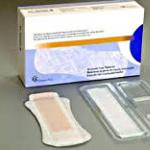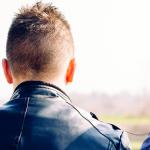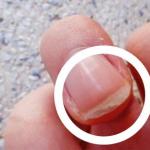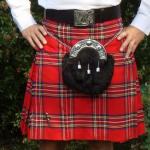The lesson notes on experimental activities in the second junior group with the paper “Gift for the Mouse” were prepared by the teacher - Notes. Abstract of GCD for experimenting with paper “Introduction to the properties of paper Lessons on properties of paper 2nd junior
Municipal autonomous preschool educational institution
“Combined kindergarten No. 216 “Polyanka”
Lesson notes on experimental activities in the second younger group with paper
"Gift for a Mouse"
prepared by the teacher
Leikom Irina Alexandrovna
Kemerovo 2014
Target : development of experimental activities, activation and enrichment of vocabulary.
Educational objectives:
Introduce children to the properties of paper and paper napkins;
Develop the ability to make discoveries and conclusions;
Teach smooth directed approach to an object.
Developmental tasks:
Develop experimental activities;
Develop children's speech;
Develop sensory abilities, tactile sensations, fine motor skills;
Develop attention, thinking, memory.
Educational tasks:
Foster independence and activity throughout the lesson;
Develop the ability to listen to each other, a sense of mutual assistance, the ability to work in a team, goodwill and responsiveness.
Cultivate accuracy in work.
Demo material:
napkins, paper, pool of water, Mouse toy, sun, glue.
P/I"Sunshine";
Fizminutka“Who has it higher?”
Handout: napkins, paper for each child.
Progress of the lesson
Educator: I have a friend whose birthday is coming up. He really wanted to meet you. So where is he? Guys, look at the house, let's knock. A little mouse looks out the window.
Mouse: Hello!
Children: Hello, Little Mouse!
Mouse: I am Mouse, what is your name? Let's get acquainted (children say their names).
Educator: Little mouse, what happened, why are you so sad and shaking.
Mouse: Oh, guys, the sun hid behind a cloud, that’s why I’m so sad and cold.
Educator: Don't be sad, Little Mouse, we know how to help you.
Educator: Guys, look how many napkins are on the table. They are paper, different colors. What color are the napkins? (children look at the napkins and name the colors of the napkins).
Educator: Now let’s put the napkins on the table and run our finger over them, the napkin is rough. Now let's see, what kind of paper? The paper is smooth (children run their fingers along the napkin and paper).
Children: Conclusion: Paper napkins – red, yellow, green, blue, white; napkins are rough, but paper is smooth.
Educator: Now let's try to crumple the napkin. Does it wrinkle? Now let’s crumple the piece of paper (children crumple the napkin and paper). Look, guys, the napkin and piece of paper are crumpled. Let's take a lump of napkin in our hand. What is he like? It (the children squeeze their hand) is soft and does not rustle. And the lump of paper is hard and rustling.
Children: Conclusion: Paper and napkins wrinkle, napkins are soft and do not rustle, but paper crumples with difficulty - it rustles.
Educator: Mouse, let's see if our paper lumps can be smoothed out. Will they become the same as they were (children smooth out napkins and paper).
Children: Conclusion: Napkins and paper were not smoothed out, they were wrinkled.
Educator: You can tear a napkin into small pieces, but try to tear the paper, is it easy to do? (children tear napkins and paper). What tears easier: napkin or paper? Show us the pieces of paper that we tore easily, and which paper we tore with difficulty.
Children: Conclusion: Napkins are thin and tear easily, but thick paper is more difficult.
Educator: Guys, we have wrinkled and torn our napkins, and now let’s blow on our little napkin pieces and watch their movement. We will blow strongly and weakly.
Blow lightly on the leaf. It will move quietly. Blow harder on the leaf. It will fly more cheerfully. (Breathing exercise) M. Mikhailova
Children: Conclusion: The napkin pieces are light and fly.
Educator: What will happen to our napkins and paper if we try to wet them? To do this, we lower them into our pool of water. (Children put napkins and paper into the water). The napkins quickly got wet, but the paper did not. Guys, let's get the napkins out of the water, what happened to them? The thin napkins became wet and torn. What about paper? The paper just got wet, did not tear, the paper is thick and dense.
Children: Conclusion: Thin napkins get wet quickly, but thick, thick paper doesn’t get wet well.
Educator: Guys, tell the Mouse what new things have you learned about paper and paper napkins?
Children: Conclusion: Napkins of different colors: red, green, blue, yellow, white; soft, wrinkled, easily torn, thin, get wet quickly.
The paper is white, dense, thick, smooth, rustles, wrinkles, breaks with difficulty, gets wet.
Mouse: Well done boys!
Educator: Little mouse! We know it's your birthday and we want to surprise you. What do you think it will be?
Educator: Guys, look what I have. This is a large sheet of paper, it is thick. Now we will stick our yellow lumps (napkins) on it. Mouse, look what we got? (teamwork).
P/I "Sunshine"
We are rays of sunshine
Mischievous people.
(Children stand in a circle and show rays - palms)
We are with the cheerful sun
We dance in a circle.
(They lead a round dance)
We’ll hide, then we’ll look out,
We simply cannot be stopped.
(Close eyes with palms, open)
Hey, funny sunshine,
Try to catch up with us.
(Children run away)
A. Brodsky
Mouse: Thank you guys, I had a lot of fun with you and learned a lot about napkins and paper. Goodbye, guys. Until next time.
List of used literature
Nikolaeva S. N. “Methodology environmental education in kindergarten." M.: Education, 1999 (methodological manual).
Ivanova A. I. “Methodology for organizing environmental observations and experiments in kindergarten.” M.: Sphere shopping center, 2004
Dybina O. V. “Classes on familiarization with the outside world in the second junior group of kindergarten” M.: Mozaika - Synthesis, 2007 (methodological manual).
Marudova E. V. “Introducing preschoolers to the world around them” (experimentation). Saint Petersburg. Childhood-press 2011.
Candidate of Pedagogical Sciences Professor Doctor of Pedagogical Sciences Professor Candidate of Pedagogical Sciences Professor 3 A Mikhailova 3 A Mikhailova JI K Nichiporenko
Document... ACTIVITIES TUTORS BY CHILDREN'S MASTERING OF EDUCATIONAL AREAS IS IN THE FOURTH YEAR OF LIFE. SECOND JUNIOR GROUP ... By based on familiar fairy tales, prepare concert For... A.E. Experimental activity middle-aged children... notes classes. - SPb.: DETST IN- ...
G. B. Gorbasheva Chief Specialist of the Image Directorate
DocumentTerms For efficient work educators By successful development of experimental activities preschoolers. I NOTES COGNITIVE CLASSES WITH ELEMENTS...
Order No. dated 20, the basic general educational program of preschool education of a municipal budgetary preschool educational institution
Educational programMovements of Garnyshev T.P. life safety fundamentals For preschoolers. Work planning, notes classes, games. Socialization Program... activities Name of age groups GKP (evening) GKP (morning) First younger Second younger Middle High Will prepare ...
Methodological materials for preschool preparation of children according to the “My World” program
Document... in all types activities in accordance with the sensitivity of the period, thereby creating a base For ... Jr – ... abstract first classes By ... For theater from paper ... prepare ... experimental ... Mouse... in a word second
Date of publication: 02/14/17
Danilova G.N.
Summary of a lesson on cognitive development in the first junior group on the topic “Fabric and paper”
Summary of GCD in the first junior group on the topic: "Fabric and paper»
Material Descriptions: I suggest you abstract direct educational activities for children in the first junior group on the topic« Fabric and paper»
TARGET: introduce children to the properties paper and fabric
TASKS:
Educational:
Teach children to identify and name the properties of objects, find objects according to the teacher’s verbal instructions, listen to and understand questions asked, answer them in sentences of 2-4 words.
.Developing:
Develop perception, visual and tactile memory.
Develop attention, thinking, speech.
Educational:
Develop independence, accuracy, cultural and hygienic skills.
Activating the dictionary: paper, textile, paper, durable, rustles, tears, wrinkles, paper.
Preliminary work: games with paper, cloth, d\i "Find out by touch", “Tie a bow for the doll”.
Equipment and materials:
Demo material:
Doll Masha, volumetric silhouettes from fabric and paper, container for conducting the experiment, silhouettes of flat dresses, 2 coffee tables.
Handout: handkerchiefs from fabric and paper, candy wrappers, napkin.
Musical accompaniment: audio recording "Sounds of the Wind"
Progress of the lesson:
Educator:. Look how many guests have arrived, let's say hello to them.
Game – greeting to M. Kartushina "Hello, palms"
Hello palms, ( "flashlights" at shoulder level) clap – clap – clap (claps in front of you).
Hello legs, (claps on knees) top - top - top (floods).
Hello cheeks, (puff up your cheeks, lightly clap them, splash - splash - splash (hands clenched into fists, lightly plop on the cheeks, as if blowing them away).
Hello my little nose, beep - beep - beep (point to nose).
Hello sponges (we smack our lips three times)
Hello guests! (we spread our arms to the sides).
Game surprise moment.
The teacher asks you to guess riddle:
I good toy, I’ll be the girls’ friend,
I can sit in a stroller, I can close my eyes.
The doll Masha came to visit the children. Mom sewed 2 dresses for Masha. Mom made one dress from fabrics, and the other from paper. Masha can't choose which dress to wear to her friend Dasha's birthday party.
The teacher offers to help Masha choose a dress.
2. Game “Which one?”.
Children are given handkerchiefs from fabric and paper.
The teacher offers to pick up a handkerchief from fabrics, and then a handkerchief from paper.
V o s p i t a t e l. Explore fabric and paper with fingers, remember what it feels like textile(soft.) and what paper(solid). Then they work together to figure out how "talking" paper and fabric(the paper rustles, fabric does not make sounds). They are trying to straighten handkerchiefs: the paper remains wrinkled, A the fabric is smoothed out.
The teacher encourages the children to think about which dress is stronger - paper or fabric? Children do conclusion: paper tears easily, A fabric can be torn, if you pull hard.
Lesson on familiarization with the outside world in the second junior group
Prepared by teacher Nikolaevskaya M.O.
Topic: “Which is better: paper or fabric?”
Program content:
To consolidate children's knowledge about paper and fabric, their properties and qualities;
Learn to establish relationships between the material from which an object is made and the way the object is used;
Teach children to make inferences and conclusions;
Continue to teach children to respond without shouting or interrupting a friend;
Cultivate kindness and a desire to help.
Activating the dictionary: paper, fabric, smooth, hard, rustles, fabric does not make sounds, a paper scarf gets wet, a fabric scarf gets wet, wrinkled, consists of threads, magnifying glass.
Equipment and visual materials: finger puppet Humpty Baltai, glasses of water, a casket, oilcloths (according to the number of children), fabric towels (according to the number of children), paper scarves (according to the number of children), fabric scarves (according to the number of children) children), things made of fabric and paper, 2 trays.
Progress of the lesson:
I. Organizing time:
Educator: Guys, do you know who Humpty-Baltay is? Want to meet him? (Yes!)
II. Introductory part:
Humpty Dumpty is in tears (the teacher, wearing a finger puppet, plays the role of Humpty Dumpty) and talks about his misfortune.....(about how his friend Knopochka asked him to help her sort things into those made of paper and those that are made of fabric, but he knows nothing about paper or fabric).
Educator: Children, can we help Humpty-Baltay? (Yes!)
Educator: But in order to help him, we ourselves must learn a lot about paper and fabric. I have a surprise for you: now we will go to the workshop together with Humpty Dumpty. Please go through these magical gates and take your seats, but don’t touch anything with your hands yet. Agreed? (Yes!). (Children take their seats.)
III. Main part:
Educator: Children, look at so many objects on the table: water in a glass, a piece of paper, a cloth. Now miracles - discoveries - will begin for us. In order for them to work out, you need to listen to me very carefully.
Educator: And now each of you will come up and touch the fabric and paper, you need to rub them
fingers. Now let’s close our eyes and “remember” what paper feels like and what fabric it feels like. (Fabric is soft, warm. Paper is hard, cold.)

Educator: Well done, guys!! I really liked your answers, did you like Humpty Dumpty? What do you remember?
Humpty Dumpty: I liked how the children answered cheerfully, because I am cheerful! What I remember is that the paper is warm and soft, and the fabric is hard! (Children correct Humpty Dumpty's answer.)
Educator: And now the next experiment, I have glass in my hands. It is not simple, but glass that can magnify objects, for example, look at how the petal of the flower in this picture enlarges. This glass is called a magnifying glass. Let's repeat its name: magnifying (children repeat after the teacher).
Educator: Now we will take this magnifying glass and first look at the fabric: what do we see? (Strings, grey colour).


Educator: That's right guys, we see the threads that make up the fabric. Now let's look at the paper. What can we say about her? (We don’t see the strings).

Educator: That’s right, when we look at paper through a magnifying glass, we don’t see the strings, but we only see yellow. Let's repeat it again so that Humpty Dumpty remembers that fabric consists of threads, but paper does not.
Educator: Guys, do you want to know if paper and fabric can talk? (Yes!)
Educator: But for this we need silence to come to us. Let's tell a poem about her in a quiet voice? (Children tell everything together):
Silence by the pond, the water does not sway,
The reeds don't make noise and the kids fall asleep.
Well done, the kids told it well, and now we open our eyes, sit quietly, quietly, and first take the paper, and so we begin to crumple it. What do you hear? (She talks, rustles).
Educator: That's right, she rustles. Let's repeat - the paper rustles. Put down the paper and take the fabric and let's listen to see if the fabric talks. We all begin to wrinkle the fabric together. What do we hear? (Nothing).

Educator: Correctly, the fabric does not speak, does not make any sound. So what can we explain to Humpty Dumpty? Humpty Dumpty, remember that when you crumple the paper, it rustles, but when you crumple the fabric, it is silent and does not make a sound.
Educator: Guys, look how crumpled our leaves are, let's try to straighten them, first we smooth the paper with our hands. What are you doing? (Can't smooth it out).
Educator: Yes, you are right, our paper is so wrinkled that it does not straighten out. Now, let's see if the fabric will straighten if we do the same thing, smooth it with our hands. Answer, what do you see? (She straightens up.)
Educator: the fabric straightens correctly when smoothed.
Humpty Dumpty: Oh, I’m tired...... I want to play!
Educator: Guys, let's play. We get up, pull up the chairs and relax.
Physical education session (to music).
Pinocchio stretched,
Once - bent over,
Two - bent over,
Three - bent over.
He spread his arms to the sides,
Apparently I couldn't find the key.
To get us the key,
You need to stand on your toes.
Educator: Well done, they played well! And now another experiment awaits us - now we will find out if our paper and fabric get dirty and we decide to wash them, what will happen to them.
Educator: First, we take the fabric, immerse it in water, and wring it out. What do we see? (She became wet).


Educator: Straighten it out and show it to Humpty Dumpty. You see Humpty Dumpty, the fabric has become wet. Now let's try to immerse a piece of paper in water. Squeeze it out. Try to straighten it. What do you see? (It got wet and began to tear.)

Educator: That's right, let's explain to Humpty Dumpty that if we decide to wash the fabric, it will get wet, and if we wash the paper, it will get wet, start to tear and have to be thrown away. So what is stronger, fabric or paper? (textile).
Educator: Humpty Dumpty, now do you understand what paper and fabric are? Guys, let's repeat it again for him:
Paper Textile
Hard Soft
Does not consist of threads Consists of threads
If its crushing rustles, If its crushing does not make sounds
Doesn't straighten when smoothed When smoothed, straightens
In water it gets wet and torn In water it gets wet and becomes wet
IV. Final part
Educator: Now that we know everything about paper and fabric, we can help you! Yes guys? (Yes).
Educator: Stand in a semicircle, near the casket, and you Dunno, be nearby. Now we will open the casket and see what lies there (the teacher opens the casket). Oh, there are so many things made of paper and fabric. I will give each of you one item, and you will place them on these two trays: if the item is made of fabric, then please put it on this tray, and if the item is made of paper, then on this one! (Children complete the task)
Educator: Now we’ll see how you helped Humpty Dumpty! (the teacher checks and mistakes are corrected together with the children).
Humpty Dumpty: Thank you guys, you are real friends!
Natalya Pakhomova
Summary of GCD for experimenting with paper “Introduction to the properties of paper”
Introduction to the properties of paper.
(Senior group)
Educator: Pakhomova Natalya Georgievna
Target: expand and clarify children's knowledge about the properties of paper.
Tasks:
Clarify and activate various types of paper in children’s speech. Explain the purpose of cardboard.
Develop the ability to independently determine the material, characterize the properties and qualities of paper.
Cultivate a caring attitude towards books.
Improve your ability to work with paper.
Material:
A box with different types of paper (cardboard, landscape sheet, napkin, tracing paper, a bowl of water, a square sheet of paper for each child for origami.
Vocabulary work:
Practice using adjectives in speech. (Smooth, thin, colored, rough, transparent, white).
Activities:
cognitive, communicative, motor, playful, productive.
Guys, what I’m going to tell you about now is in this box. Guess what we are talking about. It can be thin and thick, white and colored, smooth and rough, and we use it to make origami-style crafts...
That's right, it's paper! Let's open it and see if all the paper is the same?
She is different.
What is she like? (Smooth, thin, colored, rough, transparent, white).
Why do we need so many types of paper? Why do we need thick paper? What is it called? (Cardboard. Make boxes.)
Where else is cardboard used? (Book cover).
And for book pages, what paper is best to use? (Thin).
How should you handle a book? (Carefully). What kind of paper do you think our eye trainer is made of? (Made from cardboard).
We do eye exercises on an ophthalmic simulator.
Now let's determine why you can't wrinkle or tear the pages of a book.
Experiment with paper.
Take a piece of paper and crumple it. Now try to smooth out the paper. What has she become? (Wrinkled, not beautiful). This means that crumpled paper, when smoothed, does not return to its previous form. Therefore, when we read and look at a book, we do not wrinkle the pages of the book. And when we make crafts in the origami style, we fold the paper slowly, carefully, ironing the folds well.
Now take 2 types of paper: thin and thick. Try to break it. Was it difficult to break it? (No).
The paper tears easily, which means it is not durable.
What do you think will happen to the paper if it gets wet? Which paper gets wet faster? (Napkin).
Why? (She's thin).
We have identified some paper qualities. What do you think is the best paper for making origami-style crafts? Take it and put it on the table.
Today we will do what is said in the quatrain:
Physical education minute.
In the morning the butterfly woke up
She smiled and stretched!
1- She washed herself with dew
2- Spun gracefully
3- Bent down and crouched
And 4- flew away!
Children come to the table and fold the butterfly.
After making the butterflies, we examine them, determine what they are, what paper they are made of, and how to handle paper crafts. We will organize a butterfly exhibition.
Publications on the topic:
Lesson summary “Introduction to the properties of wood” Integrated activity for children preparatory group compensating orientation kindergarten No. 17 “Crane” “Acquaintance.
Paper plastics Introduction to the properties of paper and its application. Prepared by: Kozyreva L.A. Children love to design and play with paper.
Abstract of the GCD “Introduction to the properties of air” Program content: “Acquaintance with the properties of air” Program objectives: clarify and expand children’s knowledge about air; give children knowledge.
Abstract of GCD for experimental research activities “Introduction to the properties of paper” Topic: “Introduction to the properties of paper” Children’s age: 5-6 years Area: “ Cognitive development» Integration of areas: “Social-communicative.
 Summary of GCD on experimentation “And we will conduct the experiment - we will find ourselves in the world of paper!” and “Air is a magician” ( senior group) Purpose: to consolidate.
Summary of GCD on experimentation “And we will conduct the experiment - we will find ourselves in the world of paper!” and “Air is a magician” ( senior group) Purpose: to consolidate.
Summary of a lesson on experimenting with the properties of sand “Surprise for a little boy” Goal: To enrich children's cognitive, emotional and sensory experience about the properties of sand, using experimentation techniques (experiments).
Summary of a lesson on familiarization with the environment and development of speech “Acquaintance with the properties of wood” Topic: “Introduction to the properties of wood.” Educator; Klyuchka Larisa Ivanovna. Purpose: 1. To introduce the properties of wood and its practical uses.
Goals:
Introduce children to some of the properties of paper (thick - thin, durable) while working with it various actions(crushing, tearing, twisting).
Introduce children to the use of paper in human life.
Introduce the following words into the children's active dictionary: paper, paper, durable.
Get children interested in working with paper.
Develop thinking and fine motor skills of the hands.
Cultivate curiosity and thrift.
Equipment:
Doll “Paper Fairy” made from various different types paper.
Square pieces of paper of different types (napkin, colored paper, Whatman paper, cardboard, candy wrappers).
10 thick sketchbooks.
Container with water.
Towel.
Items made from paper (book, album, napkin, picture, coloring book, toy, newspaper, magazine, theatrical cap, etc.)
Equipment for paper construction.
Progress of the lesson:
Guys, look who's visiting us today. (Showing the doll). This is the Paper Fairy from Paper Land. In this country, everything is made of paper: houses, clothes, transport and everything, everything, everything. Look closely at the Fairy herself. Even she herself is made of... what? From paper. Can you name what kind of paper it is made from? From colored paper, from napkins, from cardboard, from newsprint.
In our world, there are also things made of paper. Can you name some of them?
Didactic exercise “What comes from paper”
Children list objects they know that are made of paper.
Attention! Listen to the task: walk around the group room, find and bring one paper object, that is, an object made of paper. Complete the task.
Didactic exercise “Bring a paper object”
The teacher asks each child to name the item brought, using the adjective “paper”.
Now think, can everything in our world be made of paper? Can there be paper houses? Why? Why don’t we make clothes out of paper in our world? Furniture? What about transport? Our houses are built from stone, furniture is made from wood, clothes are made from fabric, and vehicles are made from metal. Because these materials are durable and reliable. We’ll check with you now to see if the paper is durable. We will conduct several experiments with paper.
Paper Crushing Experience
Try crumpling the paper. Is it easy to do? Try to crumple the table at which you are sitting. Happened? Because the wood from which the table is made is strong, but the paper is fragile.
"Tearing Paper" Experience
Try tearing the paper. Is it easy to do? Can you tear the towel? Give it a try. Happened? Why? Because fabric is stronger than paper.
Experiment with water and paper
Place pieces of paper in water. Look, the napkins immediately got wet. Let's try to take them with our hands. What happened?
Are they torn? The rest of the paper is thicker than napkins, so it takes longer to soak. We'll look at it again at the end of class.
Now let’s conclude: paper is afraid of water. All paper items deteriorate when exposed to water. Paper is a fragile material.
Have you noticed that some paper is easy to crumple, while others are difficult? Is it easy to tear one paper, but difficult to tear another? Show me some scraps of paper that you easily tore? What kind of paper was difficult to tear? What do you think is the reason for this? Thin paper is easier to wrinkle and tear. And thick paper is more difficult to wrinkle and tear.
Dynamic pause “Paper candy wrappers”
We are paper candy wrappers,
There were sweets in us.
And kids have a sweet tooth
They ate the candy together.
(Children squat in a circle, holding candy wrappers in their hands. They imitate eating candy)
The wind suddenly came
And he picked up all the candy wrappers.
(They get up and, spinning, wave their arms, then run in all directions)
Spun and flew
And they sat down quietly on the ground.
(Squat down)
We'll take all the candy wrappers
(Put candy wrappers in a box)
And we'll put it in the box.
Conversation about paper
The Paper Fairy asks you guys to take care of paper and not tear it or throw it away needlessly. After all, paper is made from trees. To make 10 sketchbooks (display), one small tree had to be cut down. The more paper is made, the fewer trees there are. If you save paper, you will save a lot of trees.
Paper construction “Colored lump balls”
Children crumple colorful napkins into round balls.
Breathing exercises
Children are asked to blow on paper balls. Observe their movement depending on the force with which they are blown.
Blow lightly on the lump,
It will move quietly.
Blow harder on the lump
He will run more cheerfully.
Paper “Wreath” design
Children twist a long flagellum from a green napkin, then stick balls (flowers) rolled from napkins of different colors onto it. The teacher helps the children roll the flagellum into a ring and secure it (glue it together).
Our meeting with the Paper Fairy is coming to an end. Take a look at our paper in water. What happened to her? You can still use it. Let's play goodbye.
Didactic game “It happens - it doesn’t happen”
The teacher names an object with the adjective “paper,” and the children answer “it happens” or “it doesn’t happen,” depending on whether this object is made of paper.
Paper book
Paper chair
Paper boat
Paper towel
Paper shoes
Paper coat
paper newspaper
Well, it's time to say goodbye to the Paper Fairy. What will we say goodbye? We will also promise the Fairy to take care of paper and take good care of things made of paper.
About everything in the world:
In 1930, the film “The Rogue Song,” about the kidnapping of a girl in the Caucasus Mountains, was released in America. Actors Stan Laurel, Lawrence Tibbett and Oliver Hardy played local crooks in this film. Surprisingly, these actors are very similar to the characters...
Section materials
Lessons for the younger group:
Classes for the middle group.






